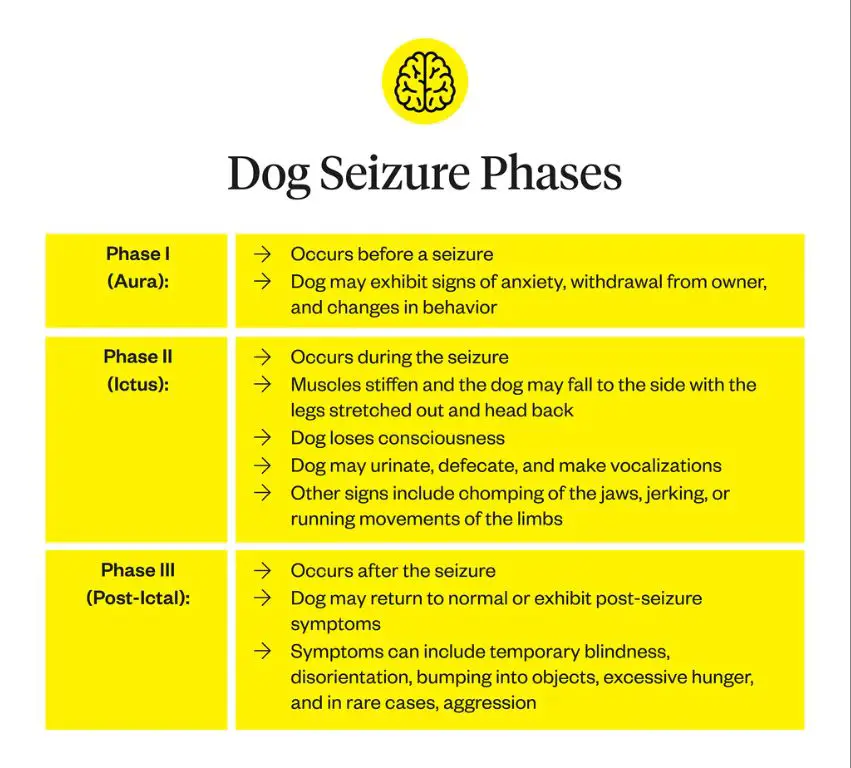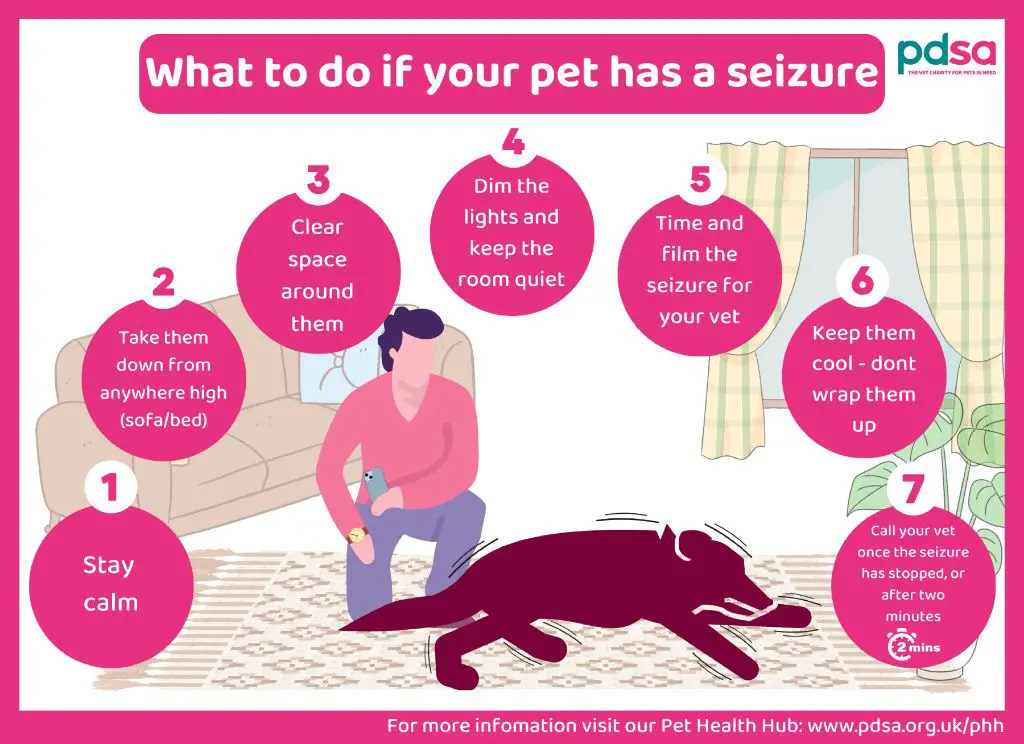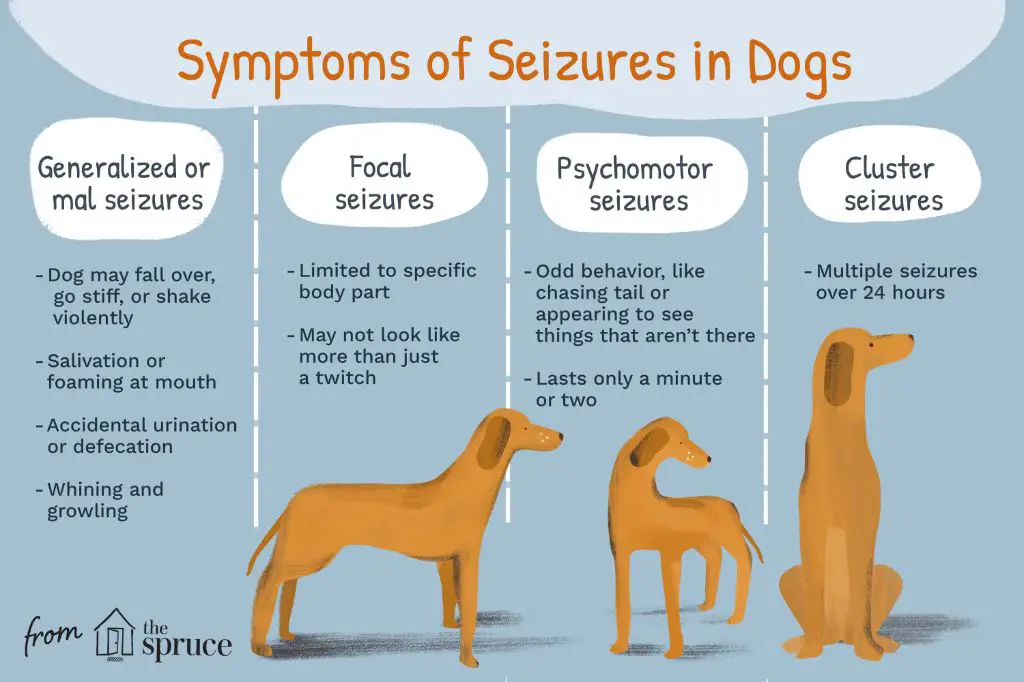Introduction
Witnessing your dog having a seizure can be a frightening experience. Their body shakes uncontrollably, they may lose control of their bladder or bowels, and they seem totally unaware of their surroundings.
Seizures in dogs are actually more common than many owners realize. Epilepsy, the most frequent cause of seizures, affects up to 5% of the canine population. While scary to watch, most seizures are over within a couple of minutes and leave no permanent harm.
Yet what should you do when your dog is seizing? The question of whether to comfort a dog during a seizure is controversial. While your natural instinct may be to console your pet, some experts advise not to interfere. In this article, we’ll discuss the risks and benefits of restraining or comforting a dog having a seizure, look at professional recommendations, and provide key takeaways on how best to care for your dog.
What Happens During a Seizure
Seizures in dogs typically occur in three phases:
Aura Phase: The aura is a precursor to the actual seizure. During this phase, which can last from seconds to hours, the dog may appear restless, anxious, or dazed. You may notice lip licking, seeking comfort, hiding, or nervous pacing.
Ictus Phase: This is the actual seizure event. During this phase, the dog loses consciousness and cannot respond to stimuli. There is no swallowing or eye movement. Muscles stiffen and jerk. Loss of bladder or bowel control may occur. Breathing may be impaired. This phase typically lasts 1-3 minutes.

Post-Ictus Phase: The post-ictus phase happens after the seizure as the dog regains consciousness. During this time, the dog may seem confused, restless, whimper, pace, or seek isolation. There may be temporary blindness. Recovery time varies from minutes to hours.
It’s important to understand that during the actual ictus seizure phase, the dog is completely unconscious and unable to feel, hear, or respond. Well-meaning attempts to restrict movement or offer comfort will not be recognized by the dog while seizing.
The Risks of Restraining or Comforting
While your instinct may be to hold and comfort your dog during a seizure, there are risks associated with restraining or interfering with a dog having a seizure episode. Attempting to restrict your dog’s movement can potentially cause injury to both you and your dog. Your dog may bite or scratch due to confusion or anxiety. Restraining your dog could also increase anxiety levels and potentially prolong the seizure.
Dogs can often have involuntary urination, defecation, vomiting or salivation during a seizure. If you attempt to hold your dog, you may end up covered in these fluids. It’s safer for both you and your dog to let the seizure run its course without interference.

There is some debate around whether restraining a dog actually worsens or prolongs a seizure, but most experts advise letting the dog move freely. The violent paddling motions help move vital oxygen to the brain. Restricting these movements could theoretically deprive the brain of oxygen and exacerbate the seizure. However, more research is needed to determine conclusively whether restraint lengthens seizure episodes.
The Benefits of Comfort
Many dog owners intuitively want to comfort their dogs during a seizure by petting or holding them. They feel that this helps reassure the dog and provides emotional support during a scary event. Some owners report that their dogs appear to recover more quickly from a seizure if the owner comforts them during it.
Additionally, the act of comforting a seizing dog can provide reassurance and emotional support for the owner as well. Seeing their beloved pet go through something frightening like a seizure can be very upsetting. Being able to comfort their dog gives the owner a sense of purpose during the seizure, which can help them stay calm.
So for some owners, comforting their dog during a seizure fulfills an emotional need and seems to help their pet. However, there are also risks associated with restraining or comforting a seizing dog that need to be considered.
What the Experts Recommend
Veterinary experts caution against restraining or excessively comforting dogs during a seizure episode. Though your instinct may be to hold and soothe your dog, this can actually cause more stress and potential injury as the dog’s muscles contract and relax involuntarily.
Instead, veterinarians recommend the following steps:
- Gently guide your dog to an open area, away from furniture or other objects, to prevent injury.
- Note the time the seizure starts and ends to inform your vet.
- Clear away any objects near your dog’s mouth to prevent choking.
- Speak calmly and pet your dog lightly if possible to provide reassurance.
- Avoid putting anything inside your dog’s mouth.
- Monitor your dog’s breathing and temperature.
The main priorities are protecting your dog from harm during the involuntary muscle movements and tracking details to share with your veterinarian. Excessive restraint or agitation can prolong the seizure, so the recommended approach is gentle guidance, reassurance, and observation.
What to Do After the Seizure
After a seizure ends, your dog will likely feel disoriented, tired, and sore. Here are some tips for providing care during this recovery period:
Gently soothe your dog by speaking softly and petting them lightly. Avoid restraining or overly-comforting them during the seizure, but gentle soothing after can help ease their stress.

Allow access to fresh water to prevent dehydration. Seizures can cause excessive drooling and panting.
Limit activity and allow your dog to rest in a safe, comfortable area. Most post-seizure effects clear within a few hours.
Contact your veterinarian to inform them your dog experienced a seizure. They may want to examine your dog or adjust medications if seizures persist or worsen.
Monitor your dog closely for additional seizures which may indicate a chronic condition. Seizures occurring in clusters may require immediate medical attention.
With proper care and veterinary guidance, most dogs fully recover after seizures and can continue living a good quality of life.
When to Seek Emergency Care
While most dog seizures are brief and not life threatening, there are some situations when you will need to seek urgent veterinary attention for your dog. This includes:
Seizures lasting longer than 5 minutes – If your dog’s seizure lasts more than 5 minutes, this is considered a medical emergency. Prolonged seizures can lead to brain damage and other complications. You should immediately contact your vet or emergency animal hospital.

Cluster seizures – Cluster seizures are multiple seizures happening close together, without your dog regaining consciousness in between. If your dog has more than one seizure within a 24 hour period, or seizures keep recurring repeatedly, this is an emergency requiring immediate veterinary care.
Other signs that warrant an urgent vet visit include seizures that are violent or unusual, seizures accompanied by uncontrollable vomiting or diarrhea, seizures in a puppy or senior dog, or if it’s your dog’s first ever seizure. In these situations, don’t wait – contact your vet right away for guidance.
While seizures can be scary to witness, try to stay calm and carefully monitor the duration and symptoms. With prompt treatment for prolonged seizures, you can help prevent further episodes and health risks for your dog.
Living with a Dog with Seizures
If your dog is prone to seizures, some adjustments to your lifestyle may help limit triggering episodes and make life easier for your pup. Here are some tips:
-
Keep a seizure diary. Track details like date, time, length, symptoms, possible triggers, and post-seizure behavior. This helps identify patterns and provides info for the vet.
-
Avoid exposure to potential triggers like flickering lights, strong fragrances, loud noises, and overstimulation which can provoke seizures in sensitive dogs.
-
Feed scheduled meals instead of free feeding to regulate blood sugar and metabolism.
-
Minimize stairs and provide ramps/lifts to lower risk of injury during a seizure.
-
Consider seizure alert training to detect oncoming episodes.
-
Have emergency contacts and veterinary information handy in case a seizure strikes when away from home.
Work closely with your veterinarian to determine the right medication protocol to control your dog’s seizures. Many dogs benefit greatly from anticonvulsant medications that reduce seizure frequency and intensity. Some lifestyle adjustments may also be recommended. With proper management, most dogs with recurrent seizures can enjoy a good quality of life.
The Takeaway
In summary, there are risks and benefits associated with restraining or comforting a dog during a seizure. The risks include the dog biting or scratching you in an involuntary reaction or you inadvertently injuring the dog. However, gentle comfort can provide reassurance and help relax the dog.
Experts caution against actively restraining a dog having a seizure, as this can cause injury or stress. It’s best to follow your veterinarian’s guidance on what to do during a seizure episode. Clear away any objects that could hurt the dog, gently stroke their side if possible, and time the seizure. Once it passes, keep the dog warm and quiet while offering praise and affection. Call your vet with concerns or if a seizure lasts over 5 minutes.
Don’t be afraid to comfort your dog in a gentle, passive way during a seizure if you are able to safely do so without restraint. Your reassuring presence can make a difference. However, always put your and your dog’s safety first, and be ready to provide any needed first aid once the seizure has ended.
Additional Resources
Here are some additional resources to learn more about dogs with seizures:
American Kennel Club– Comprehensive guide to living with a dog with seizures from a trusted authority on dog health and care.
PetMD – Detailed information on diagnosing, treating and managing seizures in dogs from veterinarian-reviewed pet health site.
ASPCA – Resources on seizure causes, treatment, and care from the leading animal welfare organization.
VCA Hospitals – In-depth guide on understanding, treating and living with a dog with seizures from network of veterinary hospitals.
Canine Epilepsy Resources – Extensive educational site dedicated solely to canine seizure disorders and epilepsy.